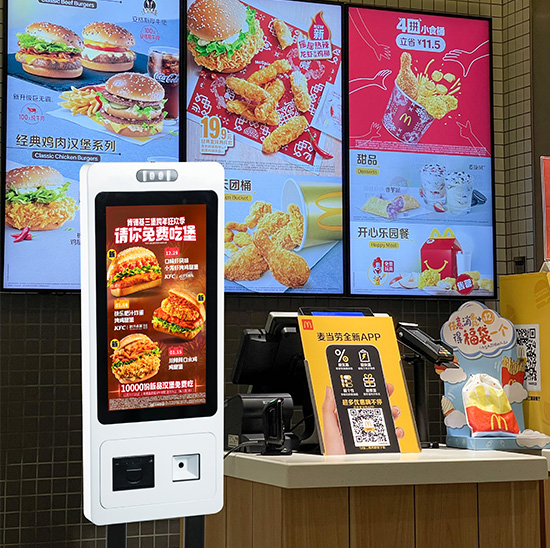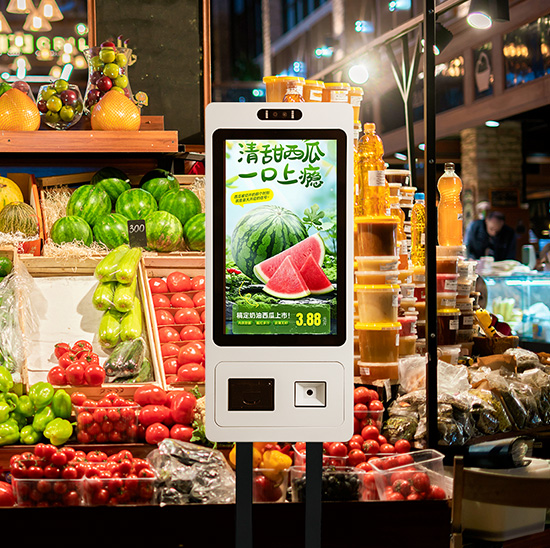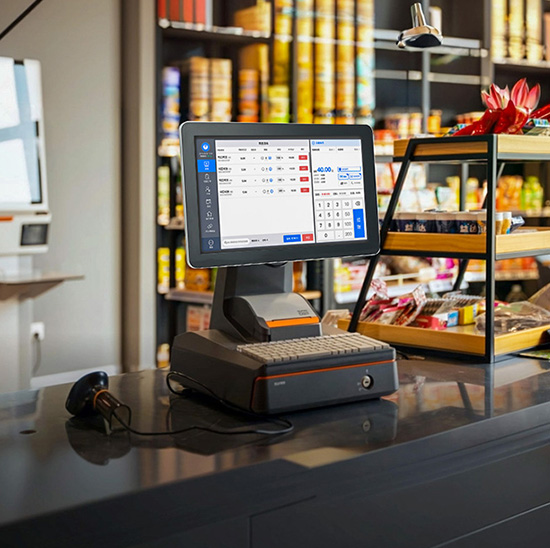Negli ambienti intensi di oggi, La segnaletica di directory chiara ed efficiente è fondamentale per guidare i visitatori in edifici come gli uffici, ospedali, e centri commerciali. Le directory statiche tradizionali vengono sfidate dalle moderne directory digitali che offrono interattività e aggiornamenti in tempo reale. Questo articolo spiega le differenze chiave, benefici, e svantaggi di entrambi i tipi per aiutare i gestori delle strutture a scegliere la migliore soluzione di directory per le loro esigenze.
Cos'è una directory digitale?
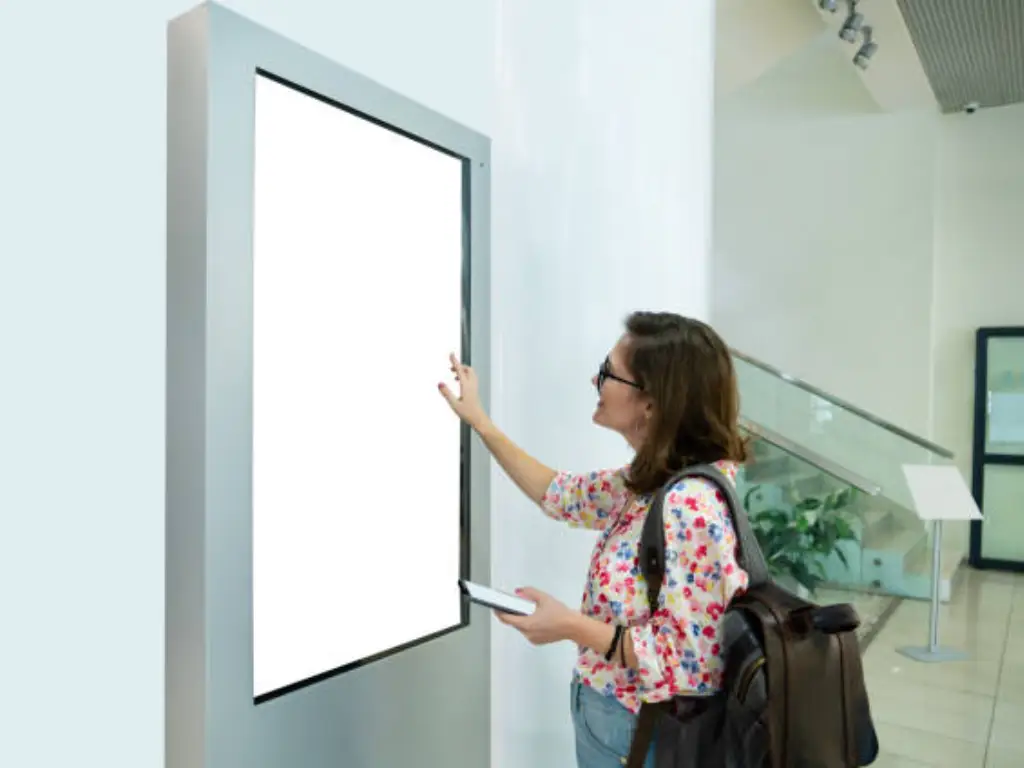
UN Directory digitale è un sistema di visualizzazione interattivo o dinamico che fornisce informazioni aggiornate sulla costruzione di inquilini, Layout del pavimento, Numeri delle camere, Servizi, e altri dati rilevanti. In genere consiste in un display touchscreen integrato con il software che consente agli utenti di cercare, navigare, e personalizza la loro esperienza di wayfinding.
A differenza della segnaletica statica, Le directory digitali consentono aggiornamenti in tempo reale senza la necessità di sostituti fisici. Spesso includono funzionalità come:
- Touchscreen interattivi per navigazione intuitiva
- Funzionalità di ricerca Per individuare le aziende, Dipartimenti, o individui
- Aggiornamenti di contenuti dinamici compresi gli orari degli eventi, avvisi, o pubblicità
- Integrazione multimediale come video o immagini
- Gestione remota tramite piattaforme basate su cloud
- Funzionalità di accessibilità Per le persone con disabilità
Le directory digitali sono spesso distribuite in grandi complessi come gli edifici per uffici, ospedali, Campus universitari, Centri commerciali, e hub di trasporto, Laddove le informazioni cambiano frequentemente e la guida ai visitatori deve essere precisa.
Cos'è una directory statica?

Directory statiche, Conosciuto anche come directory tradizionali o stampate, sono i pannelli di segnaletica fisica fissi che visualizzano informazioni che non cambiano o si aggiornano in modo molto raramente. Queste directory sono spesso stampate su materiali come l'acrilico, metallo, vinile, o carta laminata e installata a ingressi, Presentazioni, o punti di orientamento strategico.
In genere elencano:
- Nomi di affari o inquilini
- Numeri del pavimento o posizioni suite
- Mappe o planimetrie (non interattivo)
- Informazioni sulla struttura di base
Le directory statiche sono più semplici e più convenienti ma mancano di flessibilità. Quando gli elenchi degli inquilini o i numeri della stanza cambiano, I nuovi materiali stampati devono essere prodotti e installati, che può richiedere molto tempo e costoso nel tempo.
Differenze chiave tra le directory digitali e statiche
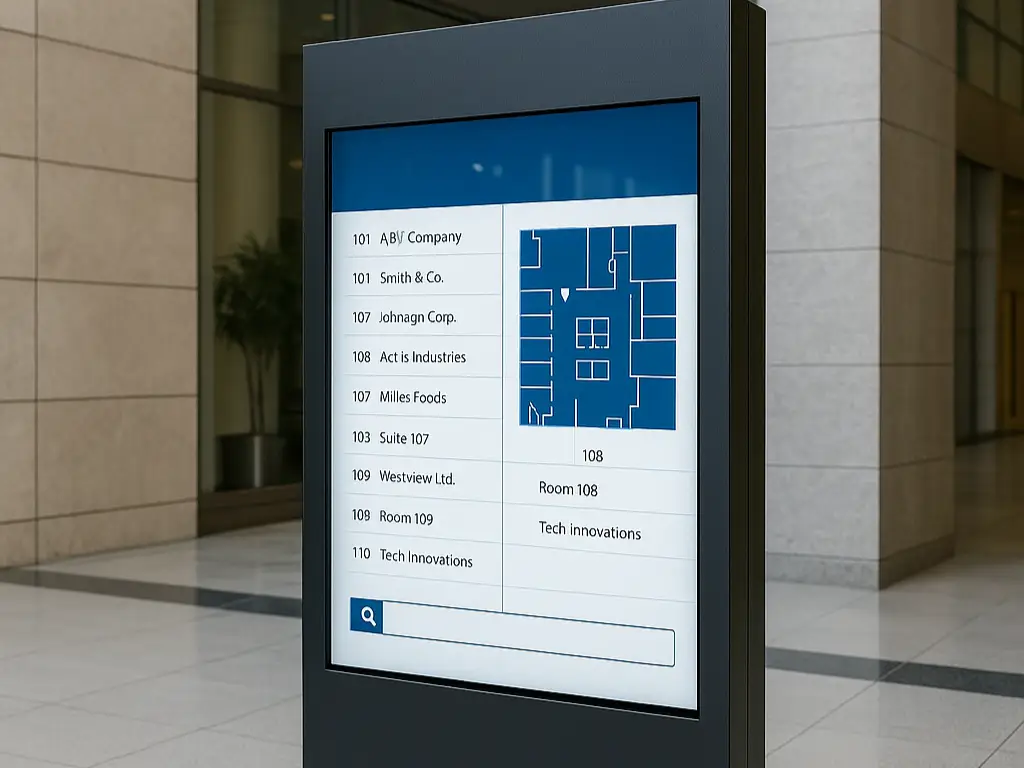
Ecco una tabella per il tuo rapido riferimento:
| Caratteristica | Directory digitale | Directory statica |
| Interattività | Abilitato al touchscreen, interattivo | Non interattivo, display fisso |
| Aggiornamenti dei contenuti | In tempo reale, remoto, frequente | Manuale, infrequente, richiede cambiamenti fisici |
| Costo | Investimenti anticipati più elevati, Costi di aggiornamento a lungo termine | Inferiore in anticipo, maggiore manutenzione nel tempo |
| Flessibilità | Altamente flessibile, Supporta più tipi di contenuti | Flessibilità limitata, contenuto fisso |
| Esperienza utente | UX migliorato con la ricerca, indicazioni, multimedia | Di base, Consegna di informazioni passive |
| Funzionalità di accessibilità | Supporta la conformità ADA, multi-lingua, Tecnica assistita | Opzioni di accessibilità limitate |
| Manutenzione | Richiede manutenzione software/hardware | Manutenzione minima ma frequenti sostituti fisici necessari |
| Appello estetico | Moderno, elegante, Aspetto personalizzabile | Tradizionale, Opzioni di progettazione limitate |
Mentre la tabella di confronto offre una rapida panoramica, È importante immergersi più a fondo nelle differenze fondamentali tra directory digitali e statiche.
Interattività è una delle distinzioni più notevoli. Le directory digitali sono in genere dotate di funzionalità touchscreen, consentendo agli utenti di cercare destinazioni, Sfoglia le mappe, o visualizzare gli elenchi con alcuni tocchi. In contrasto, Le directory statiche non sono interattive e si affidano esclusivamente a informazioni stampate o incise, offrire navigazione personalizzata o guidata.
Aggiornamenti dei contenuti sono un altro differenziatore chiave. Con sistemi digitali, Gli aggiornamenti possono essere effettuati in tempo reale tramite piattaforme basate su cloud: Ideal per edifici con frequenti modifiche agli inquilini o programmi di eventi. Directory statiche, Tuttavia, Richiedi aggiornamenti manuali, spesso coinvolgendo la ristampa e la reinstallazione della segnaletica, che può richiedere molto tempo e costoso.
Struttura dei costi Varia anche in modo significativo. Le directory digitali comportano un investimento iniziale più elevato in hardware e software ma hanno costi di gestione dei contenuti a lungo termine inferiori. Le directory statiche costano meno in anticipo ma possono sostenere spese ripetute per ogni aggiornamento fisico.
Quando si tratta di esperienza utente, Le soluzioni digitali offrono dinamiche, display coinvolgenti con funzionalità come animazioni, Selezione linguistica, o assistenza audio. Le directory statiche offrono di base, Informazioni di una dimensione di tutti che non possono adattarsi alle preferenze o alle esigenze dell'utente.
In termini di manutenzione, I sistemi digitali richiedono aggiornamenti software occasionali e potrebbero aver bisogno di supporto tecnico, Mentre i segni statici sono praticamente esenti da manutenzione ma mancano di scalabilità.
Finalmente, Estetica e branding svolgere un ruolo. Le directory digitali possono essere completamente personalizzate per allinearsi con l'identità del marchio di una struttura e modernizzare l'ambiente, mentre la segnaletica statica offre una flessibilità visiva limitata.
Queste distinzioni chiariscono che la scelta tra directory digitali e statiche dipende in gran parte dalla complessità di una struttura, bilancio, e aspettative per il coinvolgimento dei visitatori.
Pro e contro delle directory digitali
Prima di investire in un sistema di directory digitale, È essenziale comprendere sia i vantaggi che offre alle strutture moderne sia le sfide che possono derivare dall'implementazione e dalla manutenzione.
Professionisti:
- Contenuto dinamico: Le directory digitali possono visualizzare informazioni sugli inquilini aggiornati, Notifiche di eventi, Avvisi di emergenza, e promozioni all'istante.
- Navigazione interattiva: Touchscreen Le funzionalità consentono ai visitatori di cercare per nome, categoria, o posizione, Migliorare l'accuratezza di ovesting.
- Gestione remota: I gestori delle strutture possono aggiornare i contenuti in remoto tramite software, Risparmio di tempo e costi del lavoro.
- Supporto multilingue: Passa facilmente tra le lingue per ospitare diversi visitatori.
- Accessibilità migliorata: Funzioni come la guida audio, Zoom, e le modalità ad alto contrasto migliorano l'usabilità per tutti.
- Opportunità pubblicitarie: Gli spazi possono essere monetizzati con annunci digitali o messaggi sponsorizzati.
- Estetica moderna: Display eleganti completano i disegni di edifici contemporanei.
Contro:
- Costo iniziale più elevato: Le installazioni di directory digitali richiedono investimenti in hardware, licenze software, e integrazione.
- Manutenzione tecnica: Richiede aggiornamenti software periodici, Risoluzione dei problemi, e potenziali riparazioni hardware.
- Dipendenza di potere: Richiede elettricità continua e connettività di rete per funzionare in modo ottimale.
- Curva di apprendimento: Alcuni utenti non hanno familiarità con i touchscreen potrebbero aver bisogno di assistenza inizialmente.
Pro e contro delle directory statiche
Mentre le directory statiche rimangono un'opzione di segnaletica comune ed economica, Vengono con il loro insieme di limiti che possono influire sull'usabilità a lungo termine e sulla soddisfazione dei visitatori. Ecco uno sguardo più da vicino ai loro pro e contro.
Professionisti:
- Costo iniziale inferiore: La stampa e l'installazione di directory statiche sono generalmente più economiche.
- Manutenzione semplice: Nessun software o componenti elettronici da gestire.
- Affidabilità: Non dipende dal potere o da Internet, sempre visibile.
- Familiarità: Alcuni utenti preferiscono la segnaletica tradizionale per la sua semplicità.
Contro:
- Mancanza di flessibilità: Le modifiche al contenuto richiedono la ristampa e la sostituzione fisica.
- Rischio informativo obsoleto: Le modifiche o i lavori di ristrutturazione degli inquilini possono rendere le directory inaccurate se non aggiornate prontamente.
- Interazione limitata: I visitatori non possono cercare o personalizzare la loro vista.
- Vincoli di design: I pannelli statici offrono opzioni limitate per interattività o multimedia.
- Limitazioni di accessibilità: Difficile soddisfare più lingue o funzionalità di assistenza.
Fattori da considerare quando si sceglie tra le directory digitali

Non tutte le strutture hanno le stesse esigenze di segnaletica. La decisione tra una directory digitale e una statica dovrebbe essere basata sulla scala del tuo edificio, utilizzo, e piani a lungo termine. Di seguito sono riportati due scenari chiari per aiutarti a valutare quale opzione è la migliore per il tuo ambiente:
Quando una directory digitale è la scelta più intelligente
Scegli una directory digitale touchscreen se la tua struttura si adatta alle seguenti condizioni:
- Volume elevato dei visitatori in cui gli utenti hanno spesso bisogno di una guida in tempo reale o mappe ricercabili
- Cambiamenti di inquilini frequenti o layout, come negli edifici per uffici commerciali o negli ospedali
- Desiderio di estetica moderna e presenza migliorata del marchio attraverso la segnaletica digitale personalizzabile
- Necessità di supporto multilingue per servire ospiti internazionali o diversi gruppi di utenti
- Conformità agli standard di accessibilità come ADA, Offrire funzionalità come la guida vocale o il ridimensionamento del carattere
- Opportunità di monetizzazione, come vendere spazio sullo schermo per pubblicità o annunci
- Il controllo centralizzato del contenuto è importante, Abilitazione remoto, Aggiornamenti istantanei in più posizioni
Quando una directory statica ha ancora senso
Optare per una directory statica se l'edificio corrisponde al seguente profilo:
- Spazi piccoli o bassi traffico, Come le lobby residenziali, cliniche, o uffici a tenant singolo
- Rare modifiche agli elenchi degli occupanti o al layout della struttura, Fare inutili aggiornamenti frequenti
- Budget limitato dove i costi iniziali devono essere minimi e l'infrastruttura tecnologica non è disponibile
- Preferenza per la semplicità, senza bisogno di touchscreen, Aggiornamenti del software, o il coinvolgimento
- Nessun requisito per caratteristiche avanzate come la navigazione multilingue, animazioni, o interattività
- Situazioni in cui l'energia o l'accesso alla rete non sono disponibili o inaffidabili
Come prendere la decisione finale: Suggerimenti pratici per la tua struttura
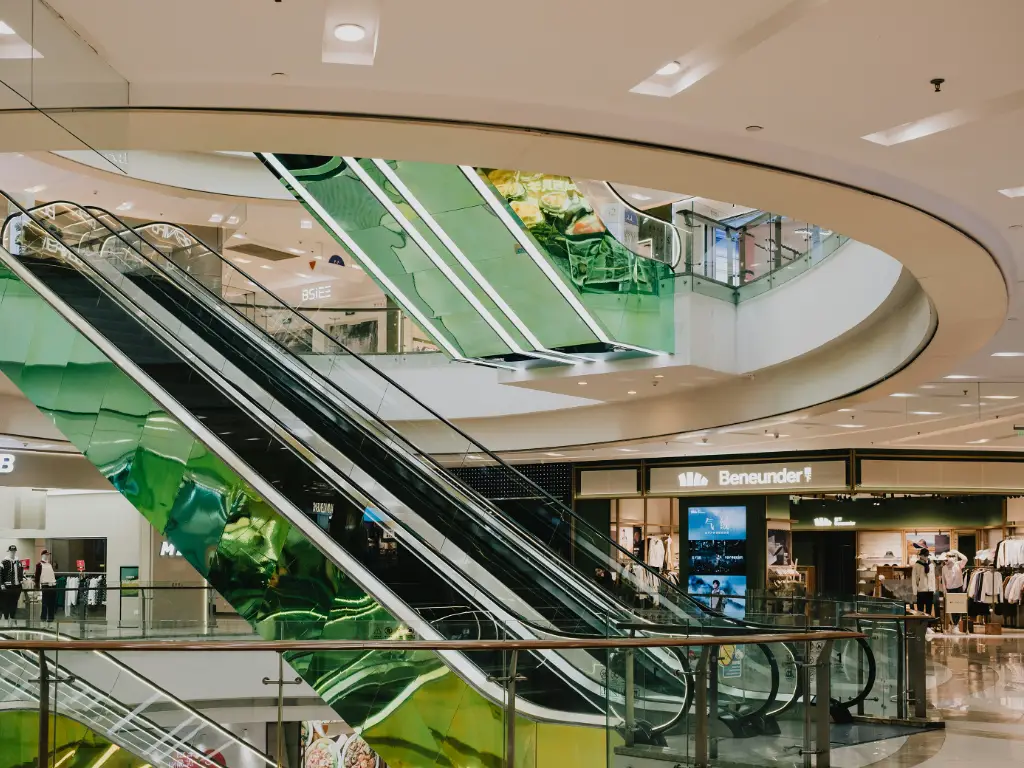
- Condurre una valutazione dei bisogni: Sondaggi le dimensioni della tua struttura, Fatturato degli inquilini, Flusso del visitatore, e feedback degli utenti per comprendere le richieste di directory.
- Definisci il tuo budget: Includi i costi per l'hardware, installazione, software, Aggiornamenti, e manutenzione del costo totale di proprietà.
- Valuta l'esperienza dei visitatori: Considera come i visitatori attualmente navigano nella tua struttura e identificano i punti deboli che un sistema di directory potrebbe risolvere.
- Dai la priorità all'accessibilità: Garantire che la soluzione prescelta sia conforme all'ADA e ospiti diversi utenti.
- Soluzioni digitali del test pilota: Se incerto, Installa una directory digitale di prova in un'area chiave per raccogliere feedback degli utenti prima della distribuzione completa.
- Pianifica la crescita futura: Scegli sistemi in grado di ridimensionare o aggiornare facilmente man mano che la struttura si evolve.
- Consultare le parti interessate: Coinvolgere i gestori di edifici, Squadre IT, inquilini, e visitatori nel processo decisionale per garantire il buy-in.
Tendenze future che modellano la tecnologia della directory digitale
Il panorama della directory digitale continua a evolversi con innovazioni che migliorano la funzionalità e l'esperienza dell'utente:
- Intelligenza artificiale (AI): Le directory basate sull'intelligenza artificiale possono offrire una navigazione personalizzata, comandi vocali, e suggerimenti predittivi basati sul comportamento dell'utente.
- Realtà aumentata (AR): L'integrazione con le app AR può consentire ai visitatori di navigare tramite smartphone o occhiali AR, indicazioni sovrapposte in viste del mondo reale.
- Gestione basata su cloud: Le piattaforme cloud consentono aggiornamenti senza soluzione di continuità e gestione remota in più posizioni da qualsiasi parte del mondo.
- Integrazione IoT: I sensori collegati possono rilevare la presenza dei visitatori, Regola il contenuto di visualizzazione in modo dinamico, e raccogli l'analisi per l'ottimizzazione dello spazio.
- Sicurezza migliorata: Le funzionalità di accesso sicuro e privacy diventeranno standard per proteggere i dati di costruzione sensibili.
- Focus sulla sostenibilità: I display e i materiali riciclabili a bene efficiente dal punto di vista energetico stanno diventando priorità nella produzione di directory.
Pronto per l'aggiornamento? Scegli la soluzione di directory perfetta per il tuo edificio
TouchWo, Un produttore touchscreen, Con la competenza in soluzioni interattive di touch screen e comprendiamo le directory di ruolo fondamentali nelle strutture moderne. L'aggiornamento a un sistema di directory digitale può trasformare l'esperienza del visitatore, semplificare la gestione delle strutture, e infrastruttura per la tua ottimità.
Se sei pronto per elevare il sistema di directory del tuo edificio, contattaci Per esplorare i display touch screen interattivi personalizzabili su misura per le tue esigenze uniche. I nostri prodotti combinano la tecnologia all'avanguardia, design elegante, e interfacce intuitive per offrire un'esperienza di directory eccezionale.

